Wondering which monuments in Indonesia to visit? Beyond its beaches and volcanoes, Indonesia harbors some incredible monuments, each whispering tales of ancient empires, spiritual journeys, and a nation’s enduring spirit. The island country is dotted with architectural marvels ranging from ancient temples and royal palaces to towering modern symbols of independence. These monuments are more than just stone and mortar. They are vibrant cultural landmarks with captivating stories etched in their stone. These national monuments in Indonesia are a must-visit.
Journey Through The Legendary Monuments In Indonesia
Visit the monuments in Indonesia and discover the island nation’s iconic temples, memorials, and symbols of independence.
1. Borobudur Temple (Central Java)
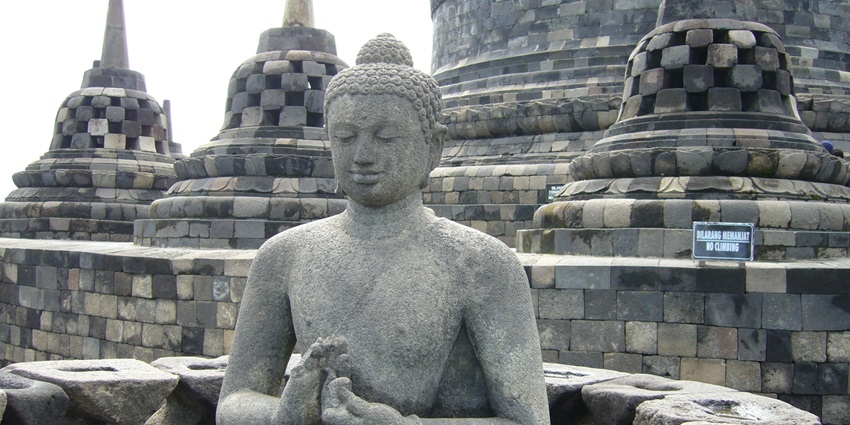
Photo: Giovanni Boccardi / Wikimedia Commons
The world’s largest Buddhist temple and a UNESCO World Heritage site, Borobudur is a 9th-century marvel. Its intricate design and sheer scale make it a quintessential example of the national monuments in Indonesia. The temple represents a peak of Buddhist art and architecture as it blends the concept of a stupa, a temple mountain, and a mandala. You must witness the sunrise over Borobudur. The sight of the mist clinging to the surrounding volcanoes and the intricate stupas silhouetted against the dawn sky is an unforgettable, almost mystical experience.
Nearest Airport: Adisutjipto International Airport (JOG)
Best Time To Visit: May – September
2. Prambanan Temple (Central Java)
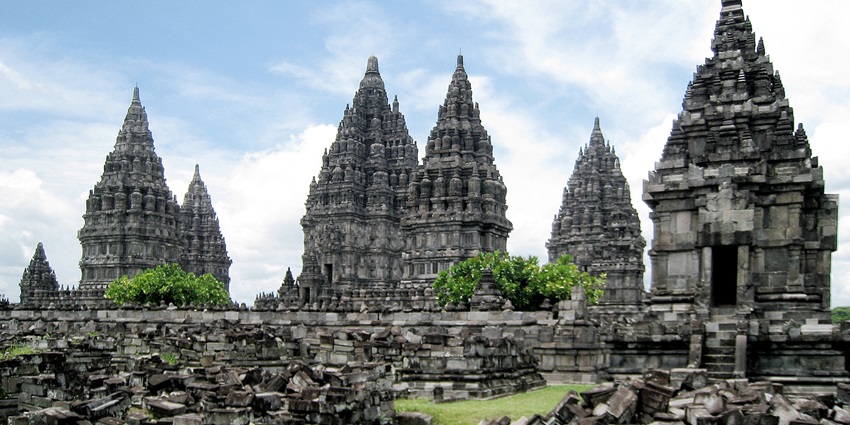
Photo: Gunawan Kartapranata / Wikimedia Commons
Just a short distance from Borobudur lies Prambanan, the largest Hindu temple complex in Indonesia and another UNESCO World Heritage site. This temple is one of the most famous monuments in Indonesia, known for its grand Hindu architecture. Dedicated to the Trimurti (Brahma, Vishnu, Shiva), its soaring central spires are a dramatic sight. Though time and earthquakes have left their mark, extensive restoration efforts have brought much of its original grandeur back to life.
Nearest Airport: Adisutjipto International Airport (JOG)
Best Time To Visit: May – September
Modes of transport: Trans Jogja public bus, taxi, Grab/Gojek rides
3. Candi Sukuh & Candi Ceto (Central Java, Near Solo)
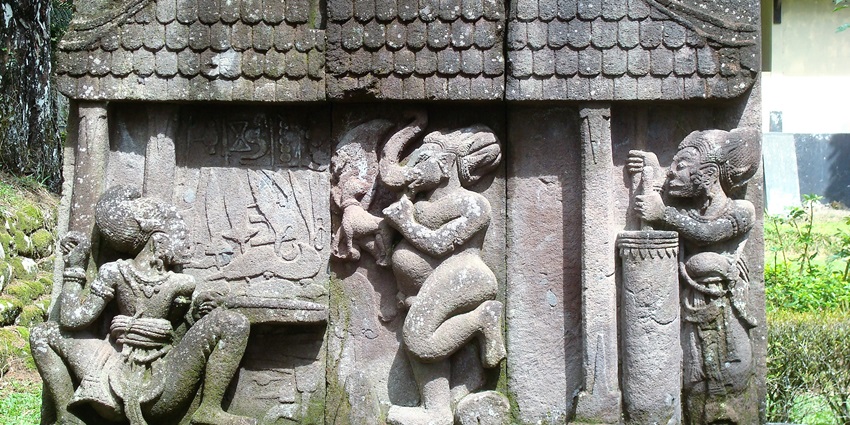
Photo: Arabsalam / Wikimedia Commons
These lesser-known but incredibly unique 15th-century Hindu temples on the slopes of Mount Lawu are a distinct departure from the grand scale of Borobudur and Prambanan. They reflect the intriguing art and spiritual practices of the late Majapahit era, making them fascinating, albeit less commonly seen monuments in Indonesia. Both temples provide breathtaking panoramic views of the surrounding tea plantations and valleys, especially in clear weather.
Nearest Airport: Adisumarmo International Airport (SOC)
Best Time To Visit: May – September
How To Get There: Private car/taxi/moto-taxi from Solo or Karanganyar
4. Tanah Lot Temple (Bali)
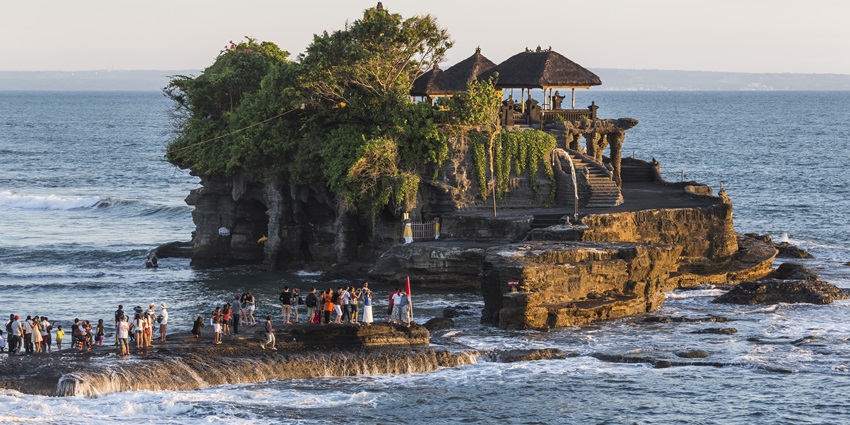
Photo: CEphoto, Uwe Aranas / Wikimedia Commons
Perched dramatically on a rocky outcrop off Bali’s southwestern coast, Tanah Lot is an iconic Hindu temple revered for its picturesque setting and spiritual importance. It’s one of the most photographed monuments in Bali. Tanah Lot means a rock in the middle of the sea, which perfectly describes the temple’s unique location, where at high tide, the temple appears to float on the ocean, surrounded by crashing waves.
Nearest Airport: Ngurah Rai International Airport (DPS)
How To Get There: Taxi, ride-hailing apps (Grab/Gojek)
5. Gunung Kawi Temple (Bali)
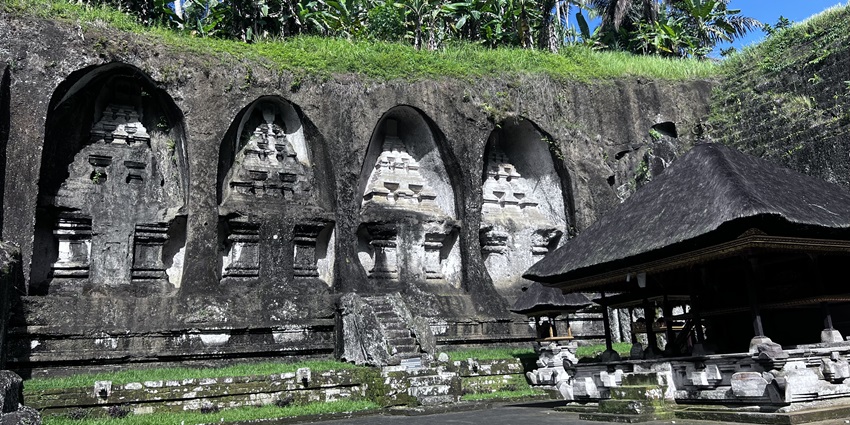
Photo: Pinterpandai.com / Wikimedia Commons
Gunung Kawi Temple is an extraordinary archaeological site dating back to the 11th century. What makes it unique are its 10 colossal rock-cut shrines (candi), carved directly into the sheer cliff faces on both sides of the Pakerisan River. These impressive, seven-meter-high monuments are believed to be memorials to King Anak Wungsu of the Udayana dynasty and his royal family. To reach this serene complex, you must descend over 300 stone steps winding through picturesque rice terraces and green jungle.
Nearest Airport: Ngurah Rai International Airport (DPS)
How To Get There: Taxi, ride-hailing apps, or tour car
6. Monas / National Monument (Jakarta)
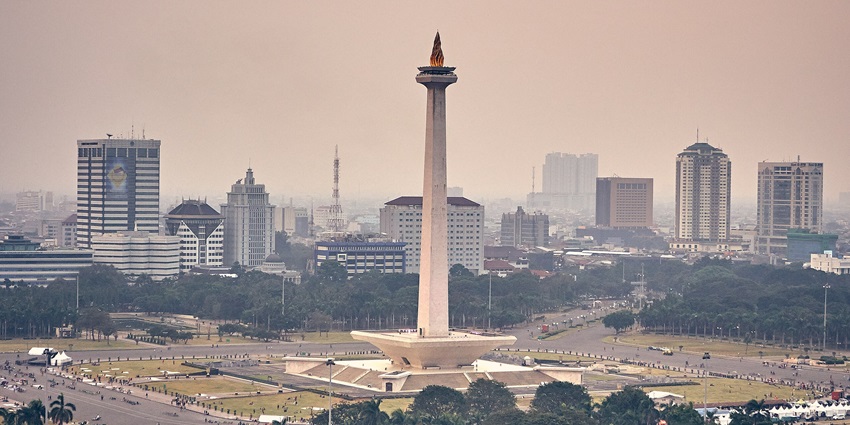
Photo: Ethadisaputra / Wikimedia Commons
Dominating Jakarta’s Merdeka Square, Monas is the iconic tower symbolising Indonesia’s unwavering struggle for independence. This iconic 132-meter obelisk, crowned with a flickering flame gilded in gold foil, was conceived by Indonesia’s first president, Sukarno, to inspire patriotism and serve as a permanent reminder of the nation’s struggle against colonial rule. Visitors can take an elevator up 115 meters to the observation deck for panoramic 360-degree views of Jakarta’s sprawling urban landscape.
Nearest Airport: Soekarno-Hatta International Airport (CGK)
How To Get There: TransJakarta bus, KRL Commuterline train
7. Heroes Monument (Tugu Pahlawan) (Surabaya)
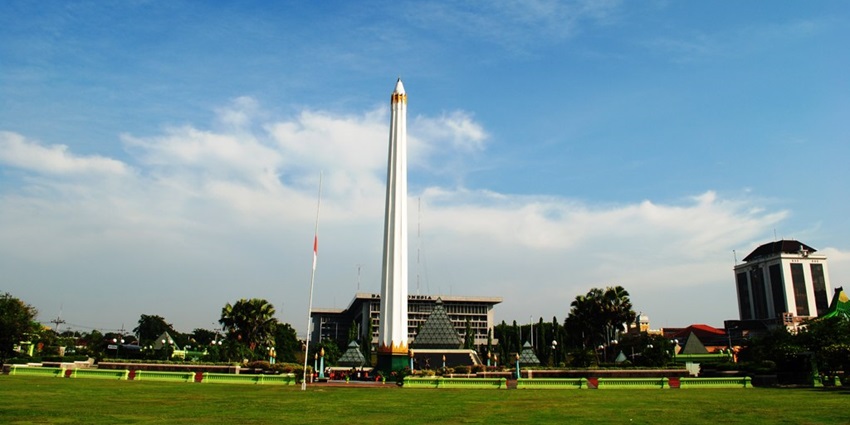
Photo: sbamueller / Wikimedia Commons
Standing tall in Surabaya, the Heroes Monument commemorates the Battle of Surabaya in 1945, a pivotal and fierce event in the Indonesian National Revolution. Beneath the monument lies the 10 November Museum, an underground space that deepens the visitor’s understanding of the battle. Through detailed dioramas, historical artifacts, photographs, and even original audio recordings of revolutionary leader Bung Tomo’s fiery speeches, the museum vividly brings to life the intensity and sacrifice of the 1945 conflict.
Nearest Airport: Juanda International Airport (SUB)
How To Get There: Public bus, taxi, or ride-hailing apps from Surabaya city center
8. Pancasila Sakti Monument (Lubang Buaya) (Jakarta)
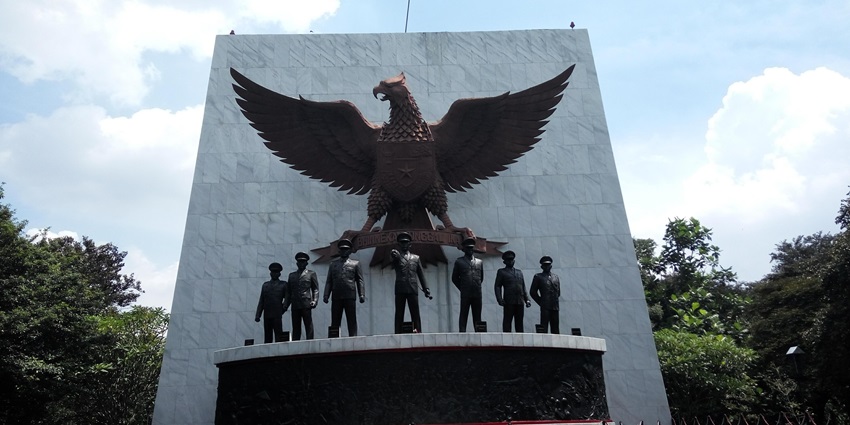
Photo: Si Gam / Wikimedia Commons
Pancasila Sakti Monument is a significant national monument in Indonesia that commemorates the victims of the failed 1965 coup attempt. It serves as a powerful reminder of the nation’s Pancasila ideology, or the state philosophy. The monument features seven imposing statues of these “Revolutionary Heroes,” honoring their sacrifice in defending the nation’s ideology. The site includes a museum with dioramas depicting the events of 1965, a “torture house,” a command post, and a public kitchen, all preserved to recreate the atmosphere of that fateful period.
Nearest Airport: Soekarno-Hatta International Airport (CGK)
How To Get There: Best accessed by taxi
9. Bajra Sandhi Monument (Denpasar, Bali)
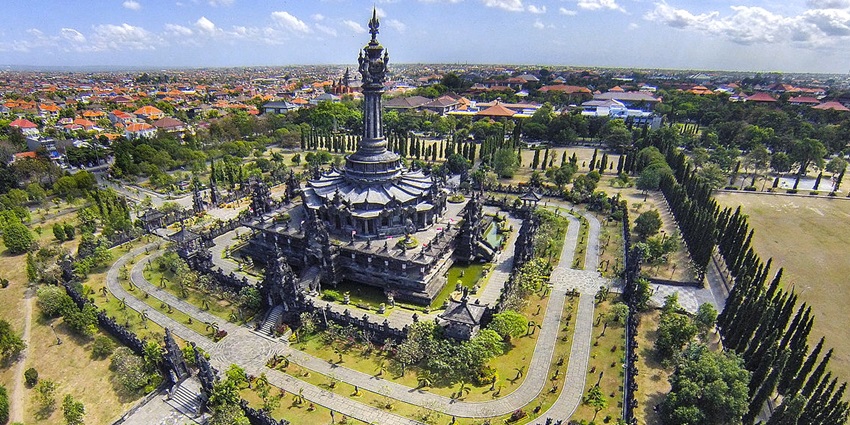
Photo: trezy humanoiz / Wikimedia Commons
Located in Denpasar, Bali’s capital, Bajra Sandhi is a relatively newer yet prominent monument commemorating the struggles of the Balinese people throughout history. Its design, inspired by the “bajra” (a sacred bell used by Hindu priests in ceremonies), beautifully blends traditional Balinese architecture with modern grandeur. The monument’s unique structure follows the “Tri Mandala” principles of Balinese architecture. Inside, the dioramas depict pivotal moments in Balinese history, from ancient kingdoms and the introduction of Hinduism to the island’s long fight against Dutch colonialism and its eventual path to independence.
Nearest Airport: Ngurah Rai International Airport (DPS)
How To Get There: Taxi, ride-hailing apps (Grab/Gojek), or tour car
10. Taman Mini Indonesia Indah (TMII) (Jakarta)
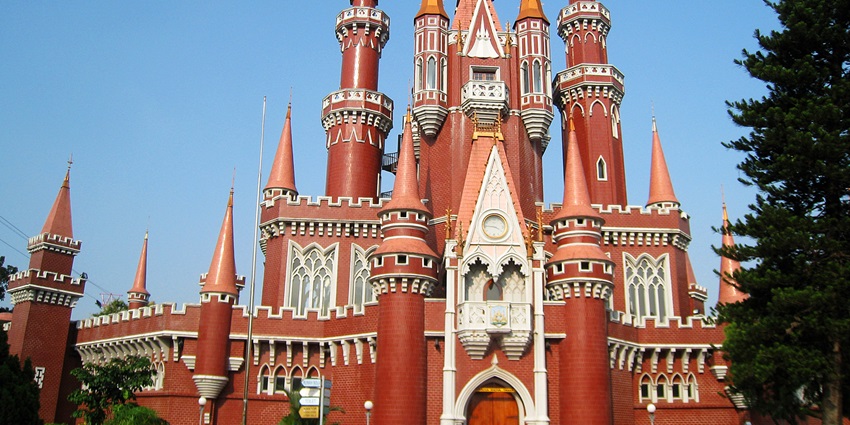
Photo: Gunawan Kartapranata / Wikimedia Commons
While not a single historical monument in the traditional sense, Taman Mini Indonesia Indah (TMII), or “Miniature Park of Beautiful Indonesia,” is a vast cultural park that depicts Indonesia’s incredible diversity. It features pavilions that represent each of Indonesia’s provinces, showcasing their traditional houses, costumes, and arts. At its heart lies the Archipelago Monument, a large-scale artificial lake shaped to mirror the geographical layout of the Indonesian archipelago. It is a powerful visual metaphor for national unity and the sheer vastness of Indonesia’s island nation.
Nearest Airport: Soekarno-Hatta International Airport (CGK)
How To Get There: Taxi, public buses
As you walk among the ancient stones of Borobudur, gaze up at the soaring spires of Prambanan, or stand before the proud National Monument in Jakarta, you’re not just observing structures, but also connecting with the very heart and soul of Indonesia. These monuments in Indonesia are living testaments to human ingenuity, spiritual devotion, and the unwavering spirit of a nation. So, the next time, plan your trip with TripXL to Indonesia to venture beyond the beaches.
Cover Photo: Mike van Schoonderwalt / Pexels


 WhatsApp
WhatsApp
 Twitter
Twitter









